April 7, 2015
I had a business trip to Orlando scheduled for the second week of April. Flights were cheaper into Jacksonville, so when my flight was booked, I made sure to arrive a few days before my business trip was scheduled to begin. This allowed time for me to play a few courses in the Jacksonville area. As a Marriott Platinum member, I was able to get a good deal on accommodations that included a round on the Stadium Course.
I arrived late in the afternoon and was able to enjoy a nice dinner in the restaurant located on the resort itself. I then made my way out to the little lake in the center of the property that has a miniature island green you can hit to and try to win prizes. I had a fair number of Hurricanes at dinner so no shot ever came close, but it was fun. I highly recommend eating at the restaurant on sight. After dinner, I purchased a logo shirt for The Players' Championship, a couple of logo balls, and then made my way back to my room to retire for the evening.
The next morning, I arrived to the clubhouse about two hours early. The drive to the clubhouse was a neat ride. It was lined with banners of past champions and the year they won. Just a short walk from the clubhouse is a circle of champions with plaques commemorating each of their tournament wins.
 |
| Entrance sign to the club. |
 |
| The clubhouse as viewed from the parking lot. |
 |
| The drive lined with flags of countries of participating players at the Players' Championship. |
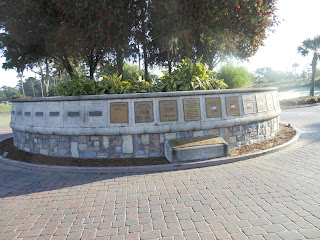 |
| Circle of past champions. |
 |
| A close up of the past champions' plaques. |
 |
| The clock located at the starter hut. |
I learned upon check-in that it was the final week they were open to the public before getting the course ready for the Players' Championship. They advised I had been paired up with three other players, two of them a father and son who had just arrived into town to play a few rounds before heading up to the Masters, and another single player. I made my way to the locker room to change and then headed out to the range to warm up. The practice facility is what you would expect at a world class facility. It includes a driving range, large putting areas, large chipping areas, etc...
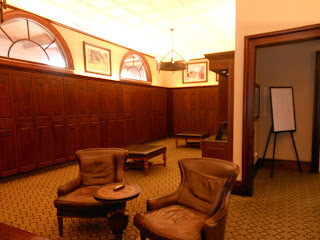 |
| The locker room at TPC Sawgrass. |
TPC Sawgrass appears several times in The World's 500 Greatest Golf Holes and one hole, the 17th, receives quite a few accolades. The course is also listed in Fifty Places to Play Golf Before You Die.
- Hole 17 is listed as one of the top 18 holes in the world.
- Hole 18 is listed as one of the top 100 holes in the world.
- Hole 16 is listed as one of the top 500 holes in the world.
- Hole 18 is listed as one of the 18 most heroic holes in the world.
- Hole 17 is listed as one of the 18 most penal holes in the world.
- Hole 17 is listed as one of the 18 best (non-ocean) water holes in the world.
- Hole 17 is listed as one of the 18 best holes in America.
- Hole 17 is listed as one of the 18 best holes designed since 1970.
- Hole 17 is listed as one of the 18 best holes you can play.
With all of the hype that surrounds the course, especially the 17th hole, I had been very excited to add it to my golf experiences. After a strong warm-up session, I met my playing partners at the first hole. While warming up, I had one of the numerous staff approach me and asked if I wanted to add a caddie. Learning that there was one available, even though I hadn't reserved one, I was pretty happy to add that to the experience. Since the holes have all been well documented by various publications, no need for me to reinvent the wheel here. Hole descriptions will be used from Golf Digest.

A slight dogleg right requiring an exacting tee shot, with drives favoring the fairway's right side improving the angle into the green. Another 20 to 25 yards added to the championship tee since 2006 ratchets up the difficulty of clearing the landing area bunkers. Drives straying too far could find moguls added in the rough beyond the bunkers. New pine trees and oaks were added on both sides of the fairway. At the long and shallow green, the rear chipping area was enlarged and the bottom of the left bunker was dropped a foot deeper.
 |
| A look down the fairway from the 1st tee box. |
 |
| A look onto the the 1st green from 75 yards out. |
 |
| The flag used on all 18 holes. |
In 2006 oak and pine trees added to the right rough pinch the landing area, with the second shot crossing the water and sand to a triangle-shaped green. If a player must lay up the fairway angle and width make for a greater challenge than most holes. The back-left bunker 2006 renovation is at least another foot deeper and the terrain behind the green was contoured to facilitate chipping areas, making for a testing up-and-down.
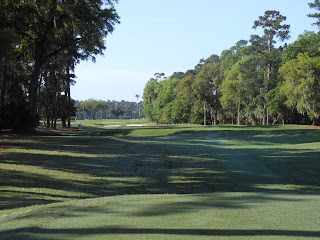 |
| A look down the fairway from the 2nd tee box. |
 |
| A look towards the 2nd green from 200 yards out. |
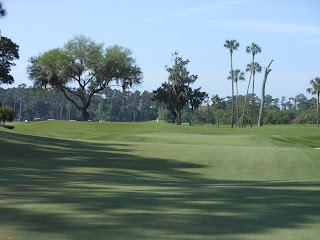 |
| A look onto the 2nd green from 120 yards out. |
 |
| A look back onto the 2nd green. |
Most players aim for the center of the 30-yard-deep green and take their chances with the putter. Accuracy is called for by grass bunkers to the right and sand left and long — the back bunker was made a foot deeper in '06 — and the green contours were changed in the renovation.
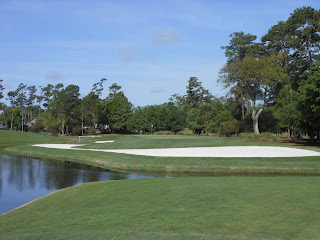 |
| A look into the green from the 3rd tee box. |
Accuracy is paramount thanks to a deep fairway bunker right of the landing area and rough-covered knolls on the left. The approach, typically no more than a wedge, leads to a two-tier green with plenty of slopes that can feed balls toward some hole locations.
 |
| A look down the fairway from the 4th tee box. |
 |
| A look into the 4th green from about 150 yards out. |
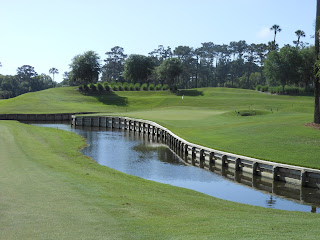 |
| A closer look at the 4th green. |
The Stadium Course's longest par 4, and the hardest hole on the front nine, is a dogleg right where favoring the right side of the fairway — even straying into the bunker — often makes for an easier approach. The green is a mixture of waste bunkers and traditional sand traps and humps and hollows, all ringed by palm trees. Most hole locations are best attacked from the left side of the putting surface.
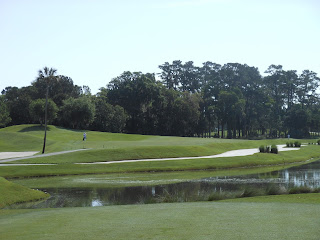 |
| A look down the fairway from the 5th tee box. |
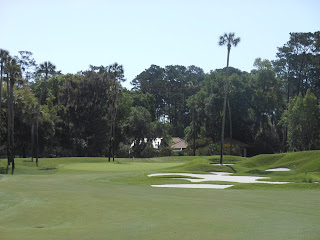 |
| A look into the 5th green from 200 yards out. |
 |
| A closer look into the 5th green. |
After several driving holes where the right side is preferable, the right here causes severe problems. Pines and palms prevent all but the luckiest players from having a shot at the green. More palms on the left side between the landing area and green can cause problems on the second shot, too. A chipping area added in 2006 sweeps around to the back-left corner, where part of a bunker was filled to extend the turf.
 |
| A look down the fairway from the 6th tee box. |
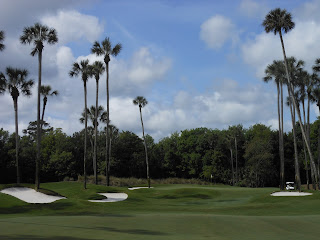 |
| A look into the 6th green from 150 yards out. |
The seventh ordinarily plays into the wind to one of the Stadium's most difficult greens to hit. The waste bunker-and-water combination on the left can become costly, and the trees jutting into the elbow of the dogleg right can menace wayward players. In 2006 even more oaks, pines and bunkers were tucked into the right rough. The smallish green runs away from the player with a sharp drop at the back. Two years ago the right-front bunker was deepened and the back-right bunker removed in favor of a chipping area.
 |
| A look down the fairway from the 7th tee box. |
 |
| A look into the 7th green from 150 yards out. |
 |
| A closer look at the 7th green. |
A necklace of bunkers, some barely large enough for a player to take a stance, circle a long, thin putting surface with several severe contours. This fifth most difficult hole gained 15 yards in the 2006 renovation.
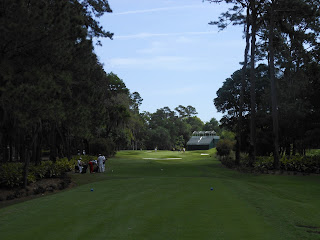 |
| A look into the green from the 8th tee box. |
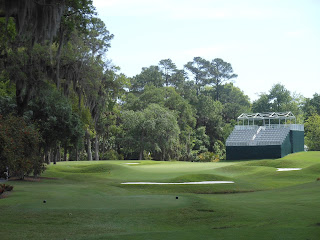 |
| A closer look at the 8th green. |
The water shouldn't come into play if you elect to treat this as a three-shot hole, but it can become a factor if you try to hit far down the right side to make for an angle at the tiny green. Oaks, pines and palms added to the left rough in 2006 also shouldn't come into play except for extremely wayward drives. Mature oaks left of the second landing area make for a tricky angle into the green, where a back-right hole location has been made available with an expansion of the green in that quadrant.
 |
| A look down the fairway from the 9th hole. |
 |
| A look down the fairway from behind the creek that splits it. |
 |
| A look towards the green from the second turn of the S-shaped fairway. |
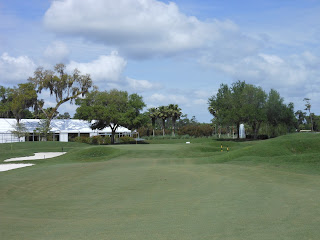 |
| A look into the 9th green from 100 yards out. |
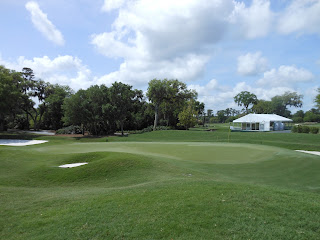 |
| A closer look at the 9th green. |
 |
| A look back onto the 9th green. |
 |
| A look at the clubhouse on the turn. |
The waste bunker crossing the fairway acts as a collar on players who might otherwise blast away from the tee. The green has tangled rough on the left and humps on the right. The green is contoured and, from the fairway, is an optical illusion: the front much narrower than a back half feeding away from the fairway. For a hole of this length it's surprisingly difficult (seventh overall).
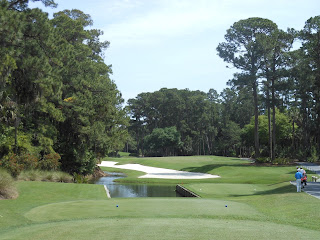 |
| A look down the fairway from the 10th tee box. |
 |
| A look into the 10th green from 220 yards out. |
Players are given so many options in the layup areas that they can become befuddled, a dilemma not diminished by the addition of 15 to 20 yards to this hole, during the 2006 renovation. Continuing down the fairway to the right could bring a large oak into play and calls for a demanding third shot to a shallow green. Crossing the waste areas and water means a tougher second shot but an easier approach. Some hole locations prevent long hitters from gunning for the flag stick with a second shot. Susceptible but daunting.
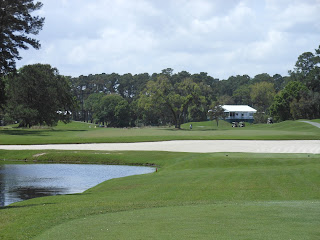 |
| A look down the fairway from the 11th tee box. |
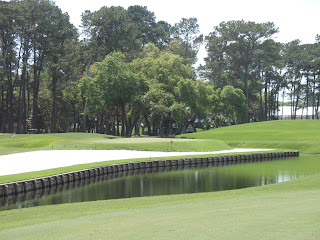 |
| A look onto the 11th green from 50 yards out. |
As with the fourth hole, a pair of precise shots are needed. A hill left of the landing area, covered grass hollows and deep rough, can block a player's view of the flag stick. Most second shots are around 100 yards, making for dead-aim approaches. In 2006 the surface was raised a foot, the right side was expanded to allow for more hole locations and the left side was reworked.
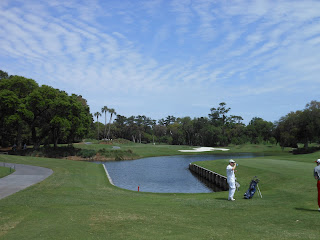 |
| A look down the fairway from the 12th tee box. |
 |
| A look into the 12th green from 125 yards out. |
On the walk from the 12th green to the 13th tee box, there are some tall pines next to the path. In those pines, located almost next to the 13th tee box, is a bald eagle's nest. On this day, the eagles were very active, with the babies crying out for their mother. That was an awesome sight!
 |
| An eagle watching over its nest. |
 |
| Both parent eagles watching the nest. |
This green may remind some people of the 16th at Augusta National GC, where a ridge feeds balls down toward the water. Three tiers demand precise tee shots, as do two deep bunkers without much wiggle room.
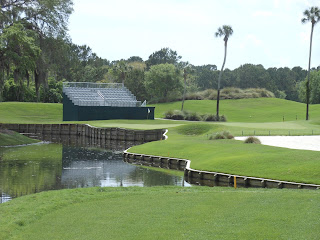 |
| A look onto the green from the 13th tee box. |
 |
| A closer look at the very difficult 13th green. |
The 14th ranks second in difficulty, thanks in part to 15 yards added two years ago but also to a second string of mounds added along the right side of the landing area, now dotted with grass clumps. That, and the waste bunker on the left, make for one of the toughest drives. The green is enormous by Stadium Course standards and has plenty of slope. A steep scoring slide can begin here without much warning.
 |
| A look down the fairway from the 14th tee box. |
 |
| A look into the 14th green from 150 yards out. |
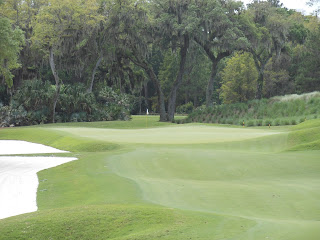 |
| A closer look at the 14th green. |
The bunker on the right off the tee was shortened in 2006, with oaks planted in the new rough, making this dogleg right more pronounced. As with the 10th green, sand flanking the green's front half gives way to a wider back half and a tier bisecting the sides. One of the shortest approach shots on the back nine and the last breather hole.
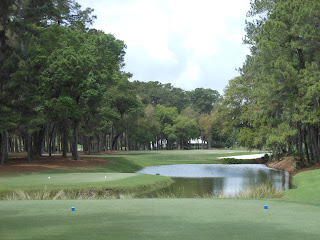 |
| A look down the fairway from the 15th tee box. |
 |
| A look into the 15th green from 130 yards out. |
 |
| A closer look at the 15th green. |
The drive must be threaded to a spot where the fairway pivots left between trees. The water is an obvious impediment not only for players trying to reach in two from the rough but for anyone looking to punch out from the left trees. The green moves toward the water; long shots, especially in firm conditions, can still make a splash. As with the par-5 11th, it's a risk-reward dream—for the viewer.
 |
| A look down the fairway from the 16th tee box. |
 |
| A look into the 16th green from 220 yards out. |
 |
| A look into the 16th green from 100 yards out. |
The simplicity of the test makes for player nightmares: hit the middle of the green and two-putt for par, but find the water and you could be there all day. The small bunker on the right side is no bargain but better than hitting 3 from the drop area. The putting surface also has more movement than most expect, making for delicate putts toward the right side.
 |
| A look onto the green from the 17th tee box. |
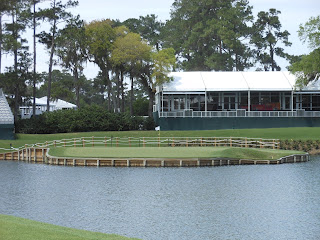 |
| A closer look at the 17th green. |
 |
| Looking at the 17th green from the top of the bleachers. |
 |
| A closer look at the back of 17. |
Two closing shots with water offering potential disaster, amped up by another 15 to 20 yards of length added in 2006. The spectator mounds and trees mean bailing out right is out of the question. The water sweeps up next to the green's left flank while rough and sand challenge on the right. Another tiered green where a long approach can cause enormous problems, especially in a tight finish.
 |
| A look down the fairway from the 18th tee box. |
 |
| A look into the 18th green from 140 yards out. |
All in all, playing the Stadium course was a very fun experience. As expensive as it is to play, and as crowded, I likely won't be back anytime soon. But, the money spent, the condition of the course, and the awesomeness of the caddies made for a very good round of golf.



